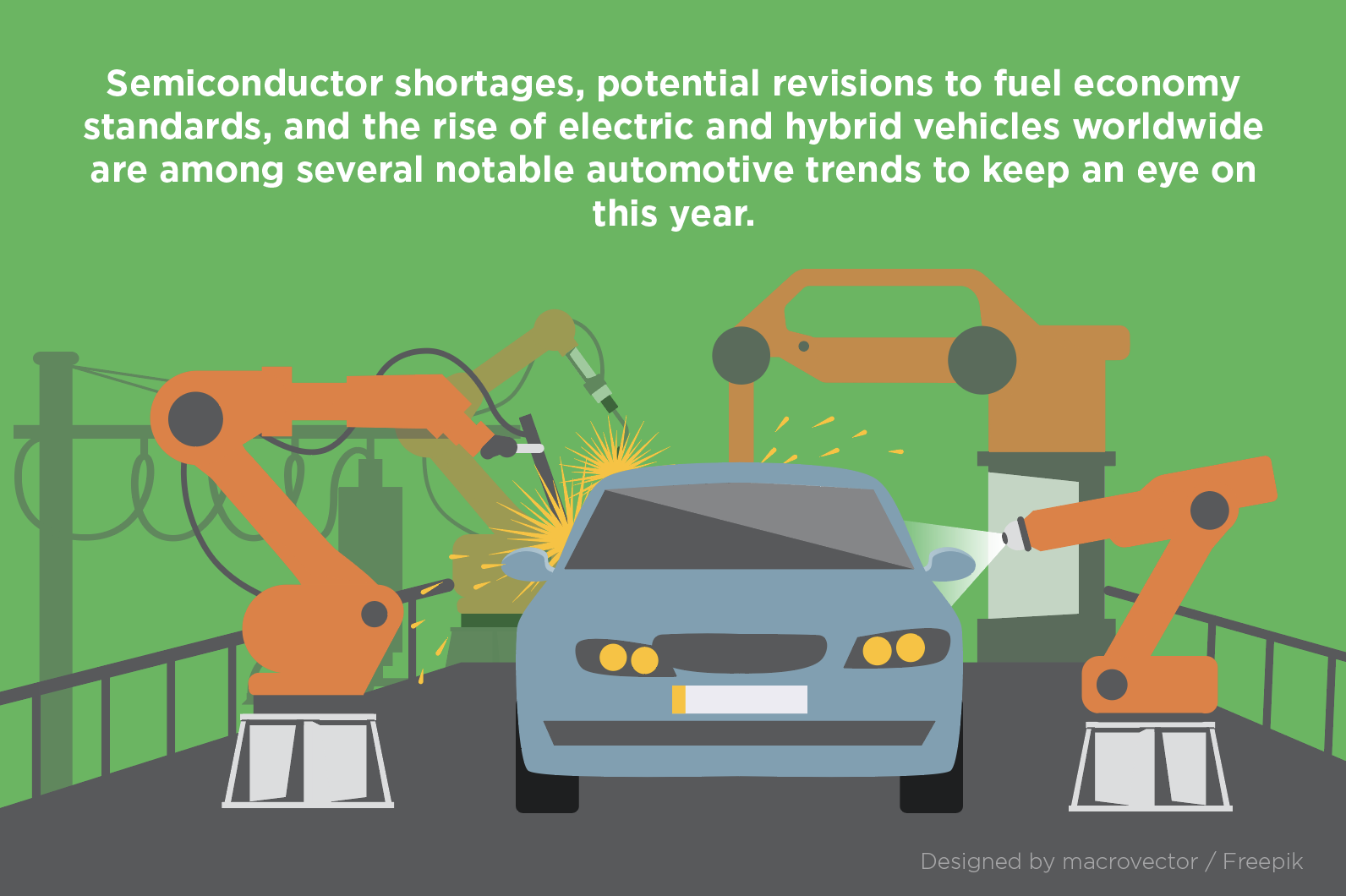Fittingly for an industry that’s all about moving people and things around, the automotive industry is in transition heading into 2021. Semiconductor shortages, potential revisions to fuel economy standards in the U.S. and the ongoing rise of all-electric and plug-in hybrid vehicles worldwide are among several notable trendlines to keep an eye on both this year and in the coming decade.
Moreover, automakers and their partners will be looking to rebound from the turmoil of 2020. The COVID-19 pandemic put a dent into sales, especially in its early months. Ultimately, 2020 sales fell approximately 15% year-over-year, a big drop but one that could have been much worse if not for low interest rates, long financing terms and the widespread desire to avoid public transportation during a pandemic.
Will that resilience continue in 2021? Let’s explore some of the big trends on the horizon for the automotive industry to find out.
1. Semiconductor shortage puts pressure on automotive supply chains
Factory shutdowns were a big cause of diminished auto sales in 2020. They could persist in 2021, but for other reasons, with the biggest one being a shortage of semiconductors. These chips are important to the microcontroller units that underpin everything from the transmission to the airbags in modern vehicles. Without sufficient supply, automakers like GM were forced to extend plant shutdowns into March 2021.
More devices than ever, ranging from gaming consoles to pickup trucks, now include semiconductors, and supply has struggled to keep pace with demand. Cryptocurrency mining, which often requires advanced chips for proof-of-work operations, has also driven up demand and exacerbated the shortage. The bottleneck is the tier 3 suppliers that manage chip foundries. Because additional chipmaking capacity takes time to build out, some automakers are rethinking their stances toward just-in-time operations and single-sourcing in their supply chains. The ongoing crunch could lead to production of 672,000 fewer light vehicles in Q1 2021, per IHS Markit.

2. Automakers place big bets on all-electric fleets and batteries
After more than 100 years as the literal motor of the auto industry, the internal combustion engine’s (ICE) days may be numbered. In January 2021, GM announced that it was aiming to sell only zero-emission cars and trucks by 2035. Jaguar announced a similar commitment not long after, with a much more aggressive target timeline of 2025. Even for automakers that haven’t explicitly committed to an electric-only goal, the rising popularity of electric vehicles (EVs) and plug-in hybrids has far-reaching implications for their supply chains and operations.
EV fleets require mass production of lithium-ion batteries. GM is building a battery plant in Ohio and spending billions overall to transition its fleet away from ICE technology. This shift comes with some challenges, as battery suppliers have traditionally been outside the automotive supply chain.
Moreover, they may need to seek alternatives to current lithium-ion batteries, for reasons of cost and material availability. Cobalt, a key material in Li-ion batteries, is produced almost exclusively in one country (Democratic Republic of the Congo), while nickel — used in Li-ion cathodes — has become expensive and in short supply due to high demand. Both cobalt and nickel are also associated with environmentally destructive mining. Tesla has begun to move some of its vehicles to lithium iron phosphate batteries, which use neither cobalt nor nickel and as such are cheaper and seen as more sustainable.
3. Fuel economy standards in flux
ICE vehicles will still be on the roads for a while. Accordingly, fuel economy standards will remain an important consideration for automakers and regulators. The Biden administration announced a review of federal fuel economy rules in January 2021. In response, the Environmental Protection Agency could reverse some of its actions from during the Trump administration, when standards were loosened and California was sued over its ability to set its own state-specific rules. Some automakers are already bound to an agreement struck with California, though notably GM is not. California mandates an average of 51 miles per gallon for an automaker’s vehicles by 2026. A new federal deal is still being negotiated as of March 2021.
The new generation of Automotive startups are focusing on building platforms with high-tech modules that are then configured to the end-customer needs. This paradigm shift from a traditional, complex automotive manufacturing process with limited flexibility is giving way to a process that is driven by the end-customer and their usage. The process of managing this supply chain is developing in a similar fashion to the semiconductor / high-tech industry. The focus is on designing efficiently and then tailoring the customer manufacturing process for order fulfillment and quality before reaching the customer.

Inspirage has helped automotive companies, including a distributor in the Middle East, modernize their supply chain operations to adjust to the ongoing changes in the industry. Read more about how we built PaaS applications to support this distributor’s employees as they worked on its shop floors.